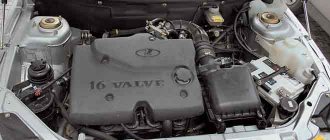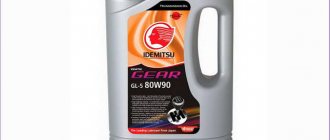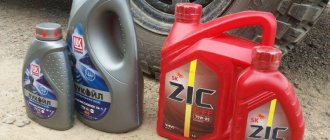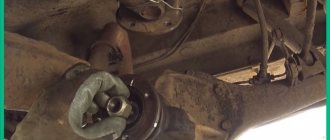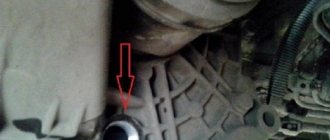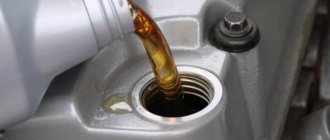A car has long ceased to be a luxury. Many families today have more than one car, which allows them to make long trips to work, on business trips and for shopping every day. But any vehicle needs regular maintenance, and the driver must know how much oil needs to be poured into the engine, as well as how to add it to the engine.
What is the oil level and how is it determined?
Everyone knows that the level is determined using an oil dipstick.
Its contrasting handle is hard to miss under the hood, and once removed, the minimum and maximum level markings are clearly visible. You can already guess that the engine crankcase is something like a bathtub into which oil is poured to lubricate the engine parts. Obviously, you need to fill it so much that the level is between o and “MAX”, preferably closer to the second. But this does not say anything about the quantity. In addition, the information given in the literature, including that supplied with the machine, sometimes contains strange information. For example:
- amount of oil in the engine crankcase;
- oil filter capacity;
- the amount of oil in its cooling system;
- the volume of oil in the engine when refilling it after repair;
- service volume when changing oil.
And so on. How much oil you need to buy specifically is not written anywhere. As well as details on this matter, explaining what this is connected with.
The need for replacement according to engine hours
The initial data is the stable average speed of the vehicle in the city and the manufacturer's recommendations for changing the lubricant. Let's say the speed in the city is 40 km/h, and the factory recommendations for replacement are 15,000 km.
To calculate engine hours, you need to divide the distance by the speed limit. In this situation, 15000/40=375 m/h. The obtained value means that after 375 operating hours of the power plant it is necessary to change the oil.
The API international standard has developed a summary table for replacing oils, depending on their type and service life.
| Type of oil solution | Operating hours |
| Mineral | 130-150 |
| SyntheticARI SJ/SHAPI SL/SMPolyalphaolefinsEsters | 230-250320-350370-400430-450 |
| Semi-synthetic | 230-250 |
Let’s assume that an SL/SM oil solution with a working life of 330 hours was poured into the vehicle engine. To determine mileage, you need to multiply 330 m/h by the average traffic of 40 km/h. As a result, the mileage until the next lubricant change will be 13,200 km.
How much oil will leak during replacement and what is the reason for this?
A fairly simple way to determine the required volume. True, it’s inconvenient, since you have to buy oil in advance, unless, like in a car service, its supplies are not limited.
A measuring container is placed under the car for testing, the drain plug is unscrewed, and all that remains is to wait until the stream, and then the individual drops, stop. You can use the scale on the container to determine how much oil needs to be changed. But under one condition - if before the procedure the level was nominal, which means you had to make sure of this in advance by looking at the dipstick.
If the oil was normal, then the resulting value will determine the service volume, that is, the one that needs to be replenished. It differs from the full filling value, since there are many places in the engine from which oil can only be drained by turning the car upside down, which is unlikely to be done during maintenance. How to disassemble the engine. Liquid can remain on the walls of all parts, in the recesses of the cylinder head, in the oil cooler, if provided for by the design, as well as in the oil filter, which is specially equipped with a check valve to prevent it from drying out when parked. The latter is especially interesting, since nothing will leak out of there, but you will still have to add this dose, since the filter will be removed and replaced with a new, completely dry one.
Need for replacement due to fuel consumption
The initial data should be fuel consumption per 100 km of movement according to passport data and actual. For example, according to the passport, consumption is 9 liters per 100 km, but the actual consumption is 11 liters. According to the passport, the oil change should be carried out every 15,000 km of vehicle movement.
Fuel consumption is calculated using the proportional method for passport and actual data separately. For passport data: 15000x9/100=1350 liters. For actual data: 15000x11/100=1650 liters.
The actual distance through which new oil must be filled is calculated by a similar proportion: 1350x15000/1650= 12270 km.
Each method can be used for any vehicle. It is only necessary to record the data at the moment of pouring lubricant into the motor.
What is the replacement procedure
Let's say the required amount is approximately known. For the reasons given above or for more precise information, which will be discussed below. But you should not immediately pour the specified volume into the engine.
- After draining the waste, you need to screw the drain plug back, not forgetting to replace its disposable gasket, if one is provided structurally. The tightening torque is indicated in the repair documentation, so if you do not have significant experience, it is better to use a torque wrench. The fact is that the gasket is usually made of soft metal; it must be slightly deformed by tightening it, but not squeezed out, and certainly not strip the thread. An undertightening is quite dangerous, since there is a risk of not only getting a slow leak, but also generally losing the plug while driving, along with the oil, causing a very fast wedge of the engine with all the ensuing consequences.
- The next step is to change the oil filter. He usually turns away using all sorts of devices, since he manages to firmly stick to his place. But the new one is screwed in by hand, there is no point in pulling it with a wrench, just remember to lubricate the rubber O-ring, it should slide well over the metal.
- There can be a lot of controversy about pre-filling the filter with oil, but there is no particular point in this, it will only waste the outside of the engine. During those seconds of operation at low speeds, while the oil pump fills the filter housing, nothing will happen to the engine; all its parts are reliably protected by an oil film, and there are practically no loads.
- After installing the filter, approximately 0.5 liters of oil less than the expected volume . This is enough to get started. Then the filler neck is closed and the engine is started. There is no need to press the accelerator; you need to keep an eye on the pressure indicator light. As soon as it goes out, this will mean that the filter is full, oil has entered all channels, and the pressure has reached the nominal level. The engine can be turned off.
- After waiting half a minute for it to drain into the crankcase, you can measure the level. The dipstick is removed, wiped and inserted back, all the way, which is very important, otherwise the readings will be false. On the newly pulled out dipstick you can see the oil level, although the product is still very clean and transparent, this will not be easy. Good lighting will be required.
- Based on the results of observations, a decision is made on topping up. Precisely adding to the level, because if you immediately pour in the excess, then removing it without a special tool is quite difficult.
- It is necessary to add based on the considerations that between the minimum and maximum marks there is usually about a liter of oil, although, of course, there is no single standard for all cars. It is better to add little by little, monitoring the process with measurements using the probe.
- At the end of the procedure, the amount of oil consumed will give the final value of the service volume, which will need to be used as a guide in the future.
But this does not mean that you need to buy oil in exactly a certain quantity. Some engines actively consume oil due to waste, up to a liter per thousand kilometers , which is the average threshold beyond which it is time to send the engine for overhaul. Moreover, many of them do this even when new, the consumption is built into the design. Despite the fact that others do not require topping up between maintenance services at all. Mixing oils is generally quite safe, but still undesirable. Knowing that your engine has such a habit, it is better to have a supply of the product that is poured into the crankcase. That is, if the system capacity is 4 liters , buy 5-liter canister.
What you need to check
- Latex gloves.
- Kitchen towel.
- Machine oil.
- Trumpet.
Oil can stain your hands, so you'll be glad to wear gloves, and a kitchen towel is great for drying off the dipstick after use. The funnel saves from spills.
Make sure you have the right oil for your vehicle.
Important: Refer to your owner's manual to confirm the oil type and fill quantity.
Step 1: Park your car on level ground
First, make sure your car is parked in the right place. If the vehicle is on a slope, the readings will not be accurate.
Step 2: Find the dipstick and wipe
Open the hood of your car and locate the dipstick. It is usually brightly colored with a round or T-shaped handle.
Remove the dipstick and wipe it clean. After you have wiped the dirty oil off the dipstick, reinsert it until it clicks.
Step 3: Remove the dipstick again and check the level
Then you should remove the dipstick again to check the oil level. There will be two marks on the dipstick indicating the optimal oil level. Your oil level should be somewhere in between.
If your oil level is below the low mark or if there is no oil at all on the dipstick, you should add engine oil immediately.
Step 4: Add oil using a funnel
- To add oil, you first need to install the oil filler cap in the engine compartment. There should be an o or outline of the oil can on it.
- Then place a funnel on the top of the spout and pour in the oil. Make sure you are using the correct oil for your vehicle.
- To understand how much oil you need; The gap between the marks on the dipstick is usually about 1 quart of oil, so you know that if your oil mark was at the low end, you need about a liter to top it up. If this mark is only halfway down, you will need about half a liter.
Try not to overfill by pouring a little and checking your dipstick using the method I just talked about.
Done. Now you just need to put the dipstick back in and clean your hands!
Why don't all engines have the same amount of oil?
This is due to many reasons, mainly the size of the engine, its displacement, the nature of ignition (diesel or gasoline), and thermal loads. The oil in the crankcase seems to rest and cool; the more of it, the lower the cyclic temperature, chemical and shock loads it receives. It actually wears out like any other engine part. And the more there is, the longer its beneficial properties will remain. But few people will like buying ten liters of an expensive product every time. Therefore, on average, the service volume of engine oil is about 4 liters . Sometimes it's less, sometimes it's more.
Goldilocks and the three cars
Since we've already established that oil is the blood that keeps your car's engine pumping, it's no surprise that maintaining the right amount in your car is critical to keeping it running without any problems.
Remember the story of Goldilocks and the Three Bears? Too hot, too cold, just like that? Well, you can think of the amount going the same way. It is not good to have too little, but it is equally bad to have too much.
What happens during each of these scenarios—driving too hard or continuing to drive in a car hungry for lubrication—and why are the consequences so severe? Let's figure it out. What happens if I put in too little?
This is what most people think about when they're worried about their car's oil levels, and as expected, you're not doing yourself any favors by driving it until it's completely dry.
Keep these three points in mind the next time you're tempted to skip your scheduled oil change, or don't want to grab an extra quart during your next change at home.
Preliminary search for information
The easiest way to find accurate information is on the Internet. This replacement procedure has already been carried out by many thousands of people, including those who love and know how to give advice. In addition to them, there are numerous sites where such information is collected and classified. You just need to make a corresponding request in any search engine, how much oil to pour into the engine, indicating the car model, engine size and year of manufacture. And don’t limit yourself to one source; you can always find the most contradictory information on the Internet. You should trust large, reputable sites, or even better, repeating numbers in different sources. And look specifically at the volume required when replacing.
What happens if I pour too much?
On the other hand, overfilling your car can be as much of a problem as too little lube for your engine.
The crankshaft, which is responsible for powering the pistons in your engine, often lies just above the oil reservoir. Typically the pump pulls oil out of the sump so it can do its job.
However, if levels are high enough to come into contact with a fast moving crankshaft, the oil becomes prone to foaming. This airy, bubbling mess is difficult for the pump to properly capture and distribute, meaning the engine won't receive the even, thin layer of lubricant it needs to perform at its best.
What is the danger of an error with quantity?
The probe shows true information, unless, of course, it is damaged. But you shouldn’t fill it “with a reserve”. In the engine, above the oil mirror in the crankcase, there are rapidly rotating crankshaft counterweights. If they start hitting the surface of the liquid, it will instantly turn into foam, which will not be able to work normally. In addition, the motor will begin to “sweat” along all the oil seals and seals. This is not that dangerous, but it is highly undesirable.
Underfilling is even worse. It leads to exposure of the oil receiver in critical situations, such as rolls, acceleration, or simply hypothermia during winter starts. Air in the pump will lead to a drop in pressure and scuffing of the rubbing surfaces. The motor will quickly waste its entire multi-thousand resource life.
The engine oil level near the minimum mark does not differ in any way from the maximum in terms of its effect on the parts. But there is one danger - it is so easy to overlook the moment when, due to waste consumption, it will decrease to catastrophic. Therefore, it is better to maintain the condition closer to the maximum level, it is safer. And carry the reserve in the trunk, but not in the crankcase.
Information about how much oil needs to be poured into the engine is usually required once during the entire operation of a particular vehicle. After the first maintenance, it is clarified, remembered or recorded, and never changes again; the motor cannot increase or decrease its internal volumes. Although there is still one exception - on an uneven road you can run over a stone, from which even the crankcase protection cannot save you. Its thin metal may not rupture, but simply deform, after which the capacity of this oil bath will decrease and the level will increase. You can repeat the procedure for determining the filling volume. But it would be much more correct, without delay, to remove and straighten the crankcase, or replace it with a new one. It’s better not to joke with the lubrication system; engine repairs can cost so much that you’ll have to replace the whole thing, which is also not cheap.
How do I know when I need to change my oil?
You'll know when this happens if your oil color is black and grainy, your engine is louder than usual, you can't remember the last time you changed your oil, or your check engine light won't turn off. Also, if you keep adding oil and the level drops quickly, your lubricant is too old and needs to be changed.
Based on years of experience, I always check the lubrication level immediately after an oil change. Recently, during a replacement, I discovered that the tank was overfilled by almost a liter. They told me there was nothing to worry about, but at my request they took out the excess - telling me about a problem they were having with dosing oil into cars from their large bulk oil tank.
I called a friend and he said that overfilling is indeed a problem and can damage the engine. If technicians drop the dipstick, they better warn about overfilling, especially if their dealers have faulty measurement systems in their oil fill procedures.
Yes, too much oil could be a problem, perhaps not at this level of overfill, but there is potential for damage when the level in the oil pan is too high.
As a result, the rotating crankshaft can aerate the oil, turning it into foam as it passes through each revolution. This oil, containing tiny air particles, cannot do a proper lubricating job. In severe cases, insufficient lubricant flow can lead to overheating - not good for the motor.
What oil is better to fill
For ZMZ 409 with an injector that meets Euro-2 standards, it is necessary to fill the volume shown in the table.
| Oil name | Price in rubles for 4 l |
| UAZ Motor Oil Premium 5W-40 (original) | 2184 |
| Shell Helix Ultra 5W-40 (analog) | 3720 |
| Liqui Moly Special Tec LL 5W-30 (analogue) | 4250 |
| Valvoline Synpower 5W-30 (analog) | 3040 |
| ZIC X9 5W-30 (analog) | 3740 |
Semi-synthetic is used as the original lubricant. It has a moderate cost and is characterized by the desired performance properties.
How to change the fluid
If you are faced with this task for the first time, here are some tips:
- Place the machine on a level surface. The ideal option is a garage pit or overpass.
- Before draining the fluid, drive the car around the city or on the highway for 30-40 minutes so that operating temperature is established inside the engine system.
- Change the oil filter every time you change the oil lubricant.
- Removing old oil is done by unscrewing the oil filler neck at the top of the engine and pulling out the drain plug under the car. The crankcase protection must be removed before replacement.
- It is not recommended to use devices for “express replacement” too often: they do not draw out the entire amount of lubricant, leaving part of the working fluid at the bottom of the unit. As a result, obsolete and new fluids are mixed, which leads to a decrease in engine life.
Changing the engine oil
Carrying out vehicle maintenance without changing the oil fluid is unwise. It must be updated regularly, and the frequency of this procedure depends on many factors.
For example, if you are planning to pour mineral oil under the hood, its beneficial effects, subject to a calm driving style, will disappear after 5-6 thousand kilometers. Do you like aggressive driving? The oil will last much less.
Semi-synthetics last a little more than 8 thousand km, but high-quality synthetics, at best, will last the car no more than 15 thousand km. Thus, the replacement interval depends on the chemical base, driving style, operating conditions and the “age” of the car.
Consumable replacement frequency
Every car owner needs to know how often the engine oil needs to be changed. Typically, the recommended frequency is indicated by the car manufacturer in the owner's manual. The average replacement frequency is ten thousand kilometers.
You need to start counting kilometers after you have drained the used oil fluid. Be sure to record the start of the countdown. In the future, when operating the vehicle, mark the kilometers you have driven on the speedometer.
In extreme cold, as well as under harsh operating conditions, you need to change the oil more often for at least a couple of thousand kilometers. This is due to the additional work that the car performs while idle in traffic jams, as well as during the morning warm-up.
Consequently, the replacement frequency for cars that are used in large cities or in winter is once every eight thousand kilometers. Changing the oil fluid at a car service costs approximately five hundred rubles. In this case, the owner of the car buys the lubricant and oil filter. Sometimes car service centers organize promotions, replacing consumables for free if the driver bought a certain oil. In any case, it is much more profitable to change the car oil yourself. This provides an opportunity to greatly save your own money and time.
Why is motor oil poured into the engine?
Before moving on to the main question, let’s determine why engine oil is poured under the hood of a car. The fact is that during operation of the entire propulsion system, each of its metal elements is subjected to large temperature overloads: the rapid interaction of parts causes a high friction force, which has a destructive effect on the entire motor.
The lubricant, which has a viscosity determined by the manufacturer, fills all the gaps between the elements, thereby activating the protective layer between them. Thus, the friction force is reduced, the temperature inside the housing returns to normal, and the entire unit operates with maximum service life.
Intervals when you need to replace
The service book for the vehicle specifies the mileage after which the lubricant solution must be replaced. In the absence of intense operating conditions, driving on the highway outside the city, the mileage between lubricant changes can be up to 15,000 km. Operating vehicles in city traffic will reduce mileage to 9000-11000 km. But these data are not completely accurate, since the condition of the lubricant is influenced by several factors, which include:
- Type and quality condition of the fuel being filled.
- Power plant volume.
- The type of lubricant that was previously filled and its condition.
- The number of hours worked by the engine.
- Technical condition of the vehicle.
- Vehicle operating conditions and power plant operating modes.
